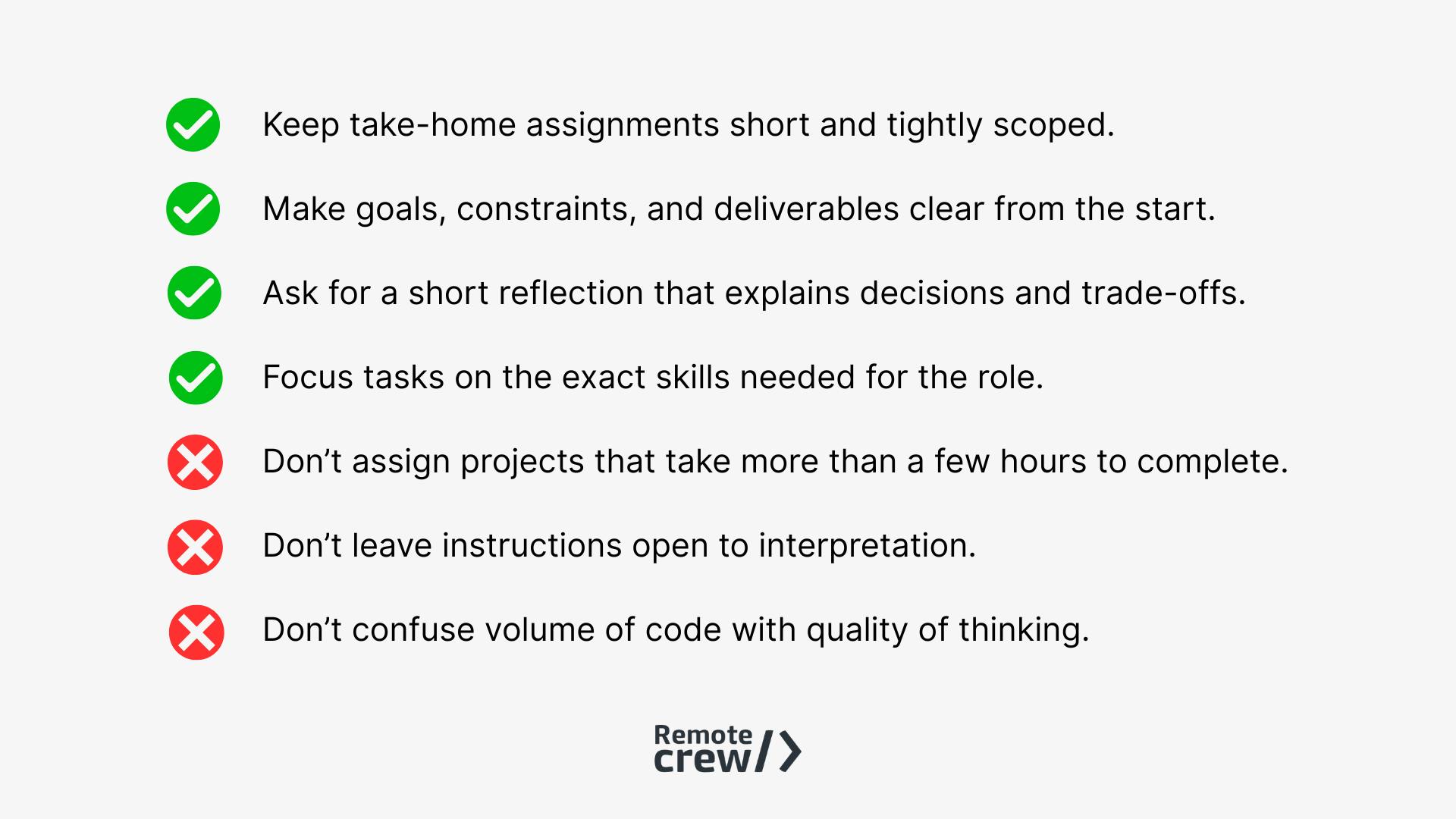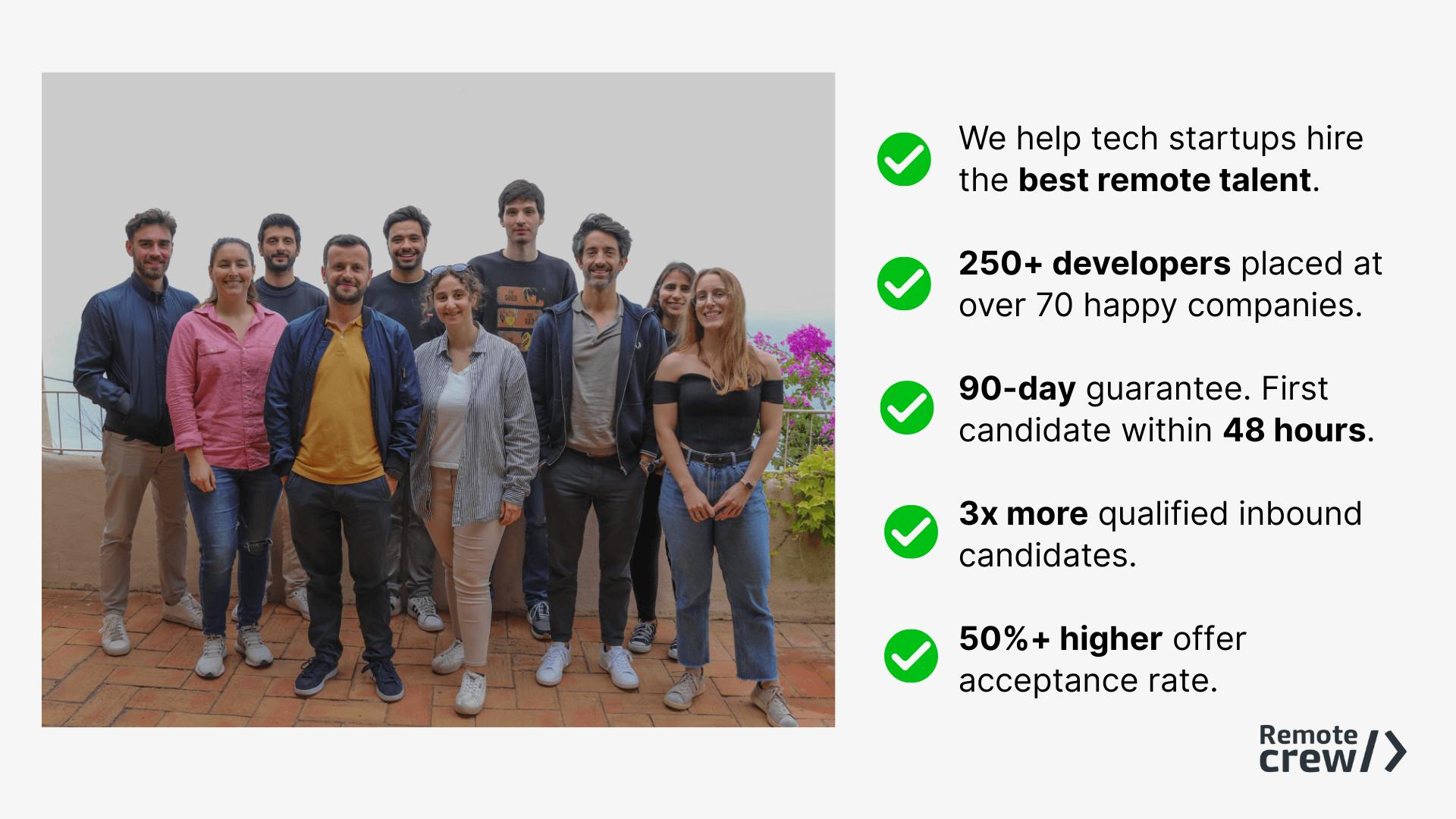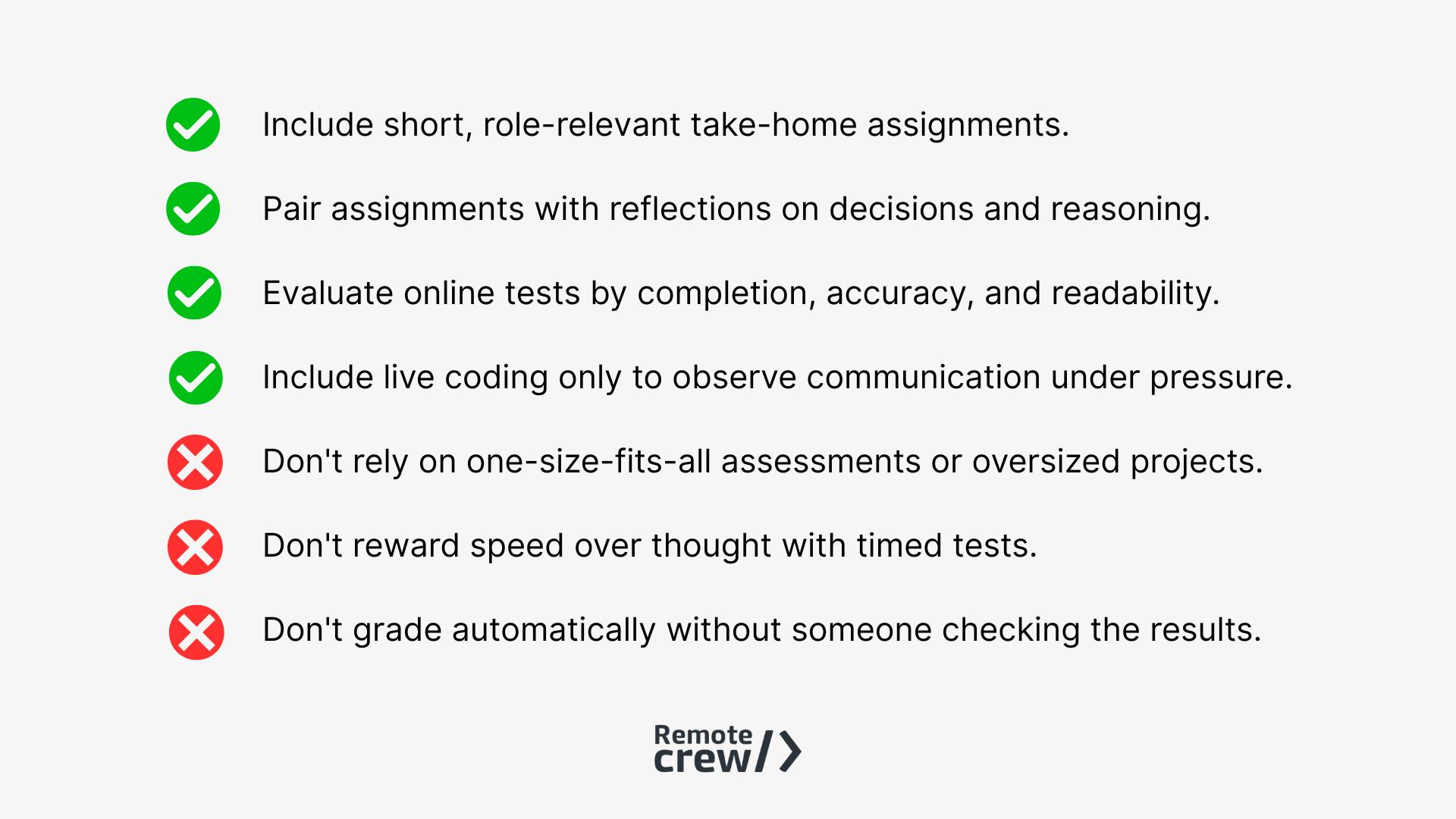I’ve found that technical assessments carry a certain weight in recruitment that few other stages replicate.
Our team at Remote Crew works with startups and scale-ups building distributed engineering teams, and assessment design comes up in nearly every hiring conversation we have.
Here are five things I want you to avoid when creating your technical assessments:
- One-size-fits-all formats that ignore role differences.
- Time limits that reward speed over thought.
- Oversized take-home projects that drain goodwill.
- Automated grading without human calibration.
- Tests that feel like performance art instead of real problem-solving.
The wrong approach to these assessments will slow your hiring velocity and filter out the wrong people.
Here are some questions we’ll unpack together:
- Is live coding a genuine skill test or just performance under pressure?
- Are online coding tests filtering talent or just inflating numbers?
- Do take-home projects actually predict success in distributed teams?
Let’s get into it.
What Does Live Coding Reveal In A Technical Assessment?
Here’s my honest take. Live coding often turns into a show of speed and composure.
What it actually reveals is how a developer handles visibility and pressure. You see how they:
- Communicate under stress.
- Recover from small mistakes.
- Adapt when problems shift mid-task.
- Explain decisions while coding in real time.
- Stay calm when every keystroke is being watched.
What we’ve seen working with distributed teams is that this setup captures performance under observation, not depth of thinking.
Live coding rarely reflects how engineers plan, test, and refine solutions in real project environments.
The focus on pace and presentation tends to favour candidates who speak well in the moment rather than those who think deeply before acting.
Aspect | Advantage | Drawback |
Live observation | Shows how candidates handle pressure in real time. | Rewards speed and presentation over deep thinking. |
Communication under stress | Reveals verbal explanation skills and adaptability. | Favours extroverted candidates who talk while coding. |
Short, guided tasks | It lets recruiters see a problem-solving approach in a controlled setting. | Provides only a limited view of overall technical depth. |
Real-time debugging | Shows ability to recover from mistakes quickly. | Does not reflect planning, testing, or long-term design skills. |
Immediate interaction | Allows assessment of collaboration style. | It can create performance anxiety that hides true capability. |
Our position is clear…
Live coding should not be the foundation of a technical assessment process, but it can play a small role in showing communication style.
We believe real evaluation happens through structured take-home work or asynchronous problem-solving.
These activities give candidates space to think and demonstrate how they actually approach engineering tasks.
Are Online Coding Tests Good For Screening Candidates?
Online coding tests save time and allow teams to screen candidates across time zones without scheduling challenges.
They quickly give you an idea of baseline skills in languages, algorithms, and problem-solving.
From our experience working with startups, the value depends entirely on design and interpretation.
Relying solely on raw scores is often misleading.
Candidates may solve problems correctly but produce brittle or unreadable code.
Timed challenges often disadvantage careful thinkers who would otherwise deliver high-quality solutions.
We suggest focusing on these five indicators during evaluation:
- Completion rate
- Accuracy score
- Time-to-submit
- Code readability and structure
- Reviewer consistency
My team has found that consistent grading and careful interpretation matter far more than the platform itself.
Well-designed tests combined with human review surface strong candidates effectively, while poorly designed automation tends to create false positives and negatives.
Here’s a table I’ve made on how to use the five indicators:
Metric | Why It’s Useful | Pitfall To Avoid |
Completion rate | Shows clarity of instructions and achievable scope. | It can reflect fatigue rather than skill. |
Accuracy score | Measures problem-solving correctness. | Ignores code readability and maintainability. |
Time-to-submit | Indicates familiarity with problem type. | Penalizes careful thinkers. |
Code readability | Highlights structured thinking and maintainability. | Often not captured by automated scoring. |
Reviewer consistency | Make sure there is a fair comparison across candidates. | Requires active calibration or results vary. |
We recommend using online coding tests as an initial filter rather than relying on them for the final verdict.
You can pair them with asynchronous assignments or practical scenarios to evaluate deeper skills and fit within your team.
How To Structure Take-Home Assignments In Technical Assessments
I like take-home assignments because they give candidates space to demonstrate problem-solving (in a real-world setting) without the pressure of a live audience.
These assignments let engineers show how they plan, structure, and document solutions in a way that mirrors actual work.

The biggest mistake teams make is giving projects that are too large or unfocused.
Oversized assignments create stress, reduce participation, and often hide what you actually want to see.
This is why you want short, targeted tasks. These are far more effective.
Two-to-three-hour builds accompanied by a lightweight reflection document will reveal both skill and thought process.
I want you to keep two things in mind:
- Clarity
- Scope
Here’s what I mean…
Candidates should understand the goal, constraints, and expected deliverables without needing extra guidance.
You want the challenges to be manageable in a few hours and focus on the skills relevant to the role.
Including a short reflection allows candidates to explain their decisions, trade-offs, and testing approach, which shows reasoning and thought process more than code alone.
What we’ve seen working with distributed teams is that clear instructions and thoughtful scope consistently lead to better participation and more meaningful insights.
Candidates who provide reasoning alongside code demonstrate stronger collaboration potential and alignment with team practices.
Our advice is to keep take-home assignments focused, time-bound, and paired with a simple reflection.
You’ll find that this approach captures technical ability, reasoning, and communication, which are the core signals that predict success in a distributed engineering environment.
We Help Technical Teams Hire With Confidence
We know most teams struggle to find incredible remote developers.
It’s difficult to separate the signal from the noise, but that’s where our team at Remote Crew comes in.

We help companies design hiring processes that actually reflect how their teams work.
What does that look like? Well, it can mean anything from refining your technical assessments to building take-home assignments that surface real ability and improving how you review results.
No matter what part of your hiring process needs tweaking, our goal is simple: make every stage of hiring meaningful.
With over 250 developers placed across 70 happy companies, we have a proven track record of building technical teams.

Tech hiring insights in your inbox
From engineers to engineers: helping founders and engineering leaders hire technical talent.
We will only ever send you relevant content. Unsubscribe anytime.







